The Cubism painters rejected the inherited concept that art should copy nature. In Cubism objects are reduced and fractured into geometric forms. Objects are analysed, broken up and reassembled in a abstracted form - instead of depicting objects from one viewpoint, the artist depicts the subject from a multitude of viewpoints. The Cubists challenged conventional forms of representation, such as perspective, which had been the rule since the Renaissance. Their aim was to develop a new way of seeing which reflected the modern age. The term Cubism is used in association with a wide variety of art produced in Paris during the 1910s and 1920s. Variants such as Futurism (Italia) and Constructivism (Russia) developed in their countries.
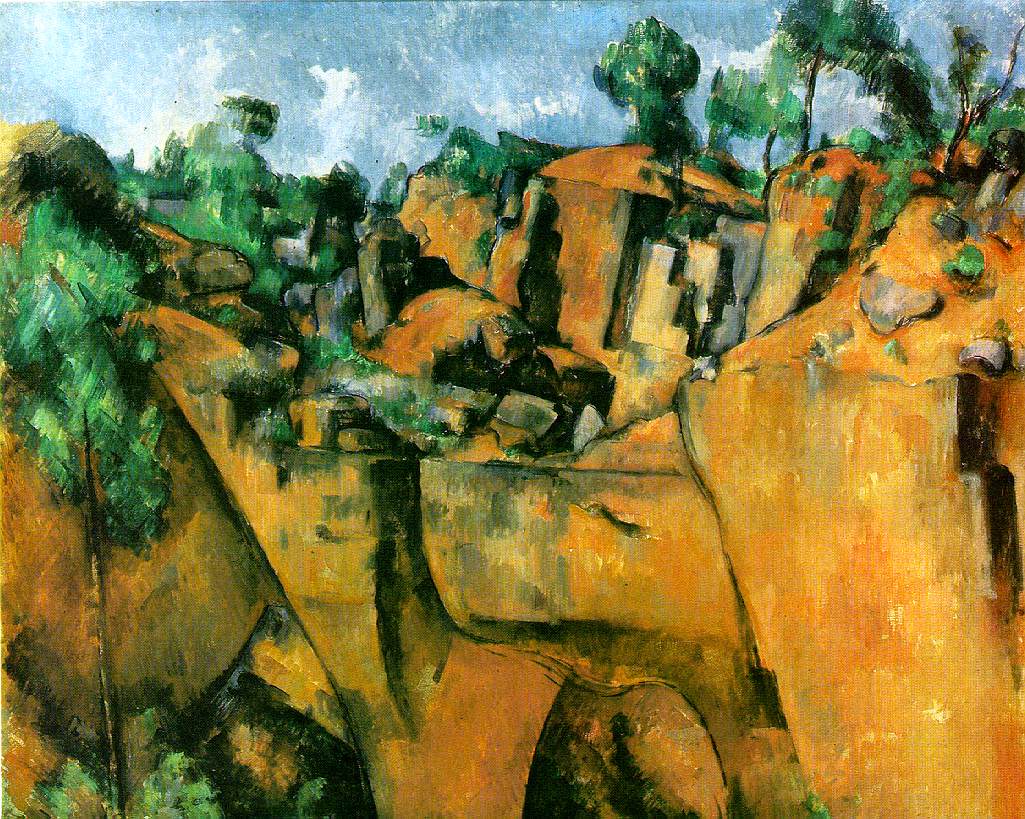 |
| PAUL CEZANNE 'Bibemus Quarry', 1895 |
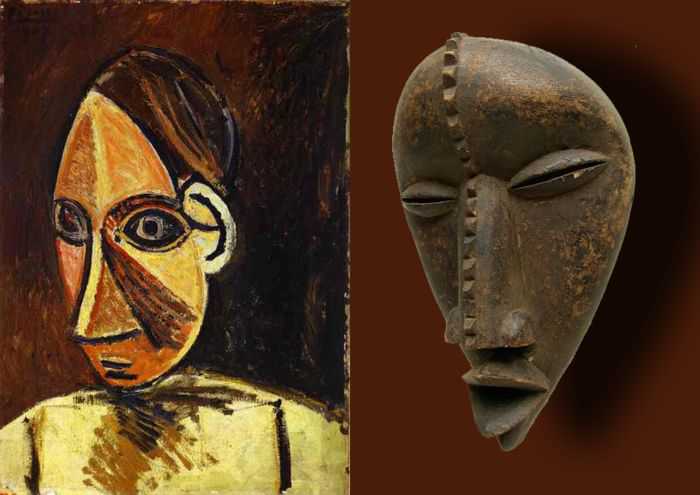 |
| The influence of african art: LEFT: Pablo Picasso, 'Head of a Woman', 1907 (oil on canvas) RIGHT: Dan Mask from West Africa |
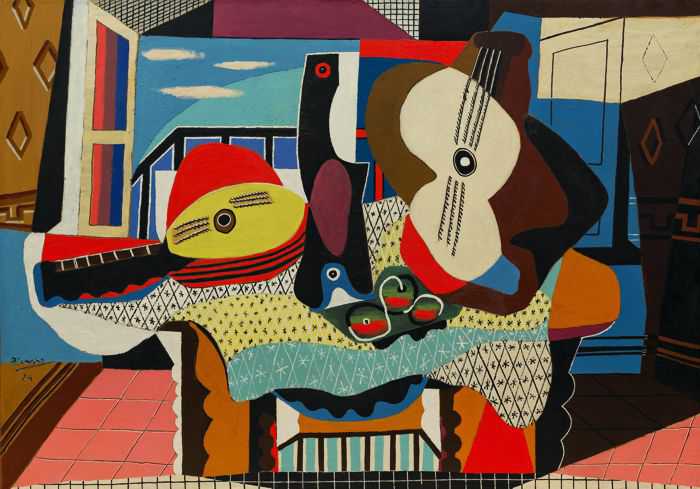 |
| 'Still Life with mandolin and Guitar', 1924 Pablo Picasso |
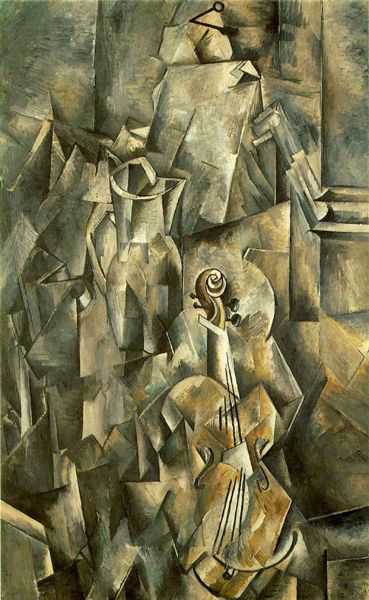 |
| 'Violin and Jug', 1910 Georges Braque |
 |
| Pablo Picasso "Le Jeune Fille Devant Un Miroir |
,_oil_on_canvas,_204.5_x_188.3_cm,_Philadelphia_Museum_of_Art.jpg) |
| Pablo Picasso, 1921, Nous autres musiciens (Three Musicians) |
DE STIJL
Dutch for "The Style", was a Dutch artistic movement founded in 1917 in Amsterdam by Piet Mondrian and Theo Van Doesburg. The term De Stijl is used to refer to a body of work from 1917 to 1931 founded in the Netherlands
De Stijl advocated pure abstraction and universality by a reduction to the essentials of form and colour; they simplified visual compositions to the vertical and horizontal directions, and used only primary colours along with black and white. The movement proposed ultimate simplicity and abstraction through which they could express a Utopian idea of harmony and order.The harmony and order was established through a reduction of elements to pure geometric forms and primary colors.
"We speak of concrete and not abstract painting because nothing is more concrete, more real than a line, a color, a surface." Theo Van Doesburg
 |
| Tableau 2, 1922. Piet Mondrian. Guggenheim Museum, New York |
 |
| Composition II in Red, Blue, and Yellow, 1930 Piet Mondrian |
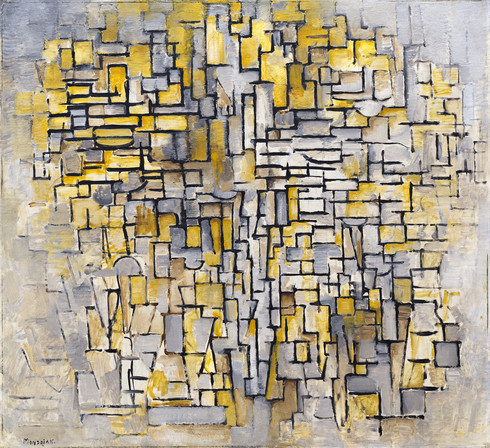 |
| Tableau No. 2/Composition No. VII, 1913 Piet Mondrian |
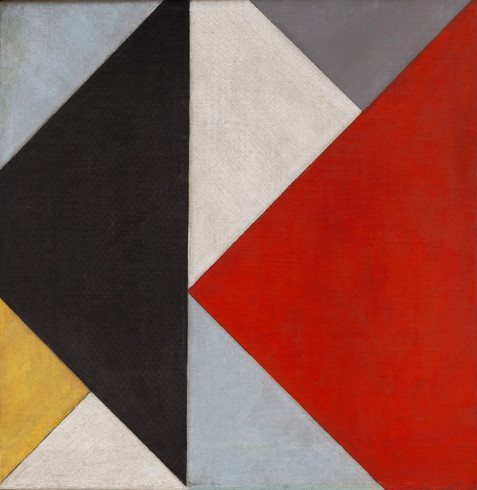 |
| Counter-Composition XIII (Contra-Compositie XIII), 1925–26, Theo Van Doesburg |
| Red and Blue chair, designed by the Dutch modernist Gerrit Rietveld in 1918. |
Filippo Marinetti expressed a passionate loathing of everything old:
''We want no part of it, the past...We the young and strong Futurists''Futurism movement glorified themes associated with contemporary concepts of the future, including speed, technology, youth and violence, and objects such as the car, the aeroplane and the industrial city, all that represented the technological triumph of humanity over nature. Among modernist movements, the Futurists rejected anything old and looked towards a new Italy. This was partly because the weight of past culture in Italy was felt as particularly oppressive. In his Manifesto, Marinetti asserted:
‘We will free Italy from her innumerable museums which cover her like countless cemeteries.’Futurism architecture: The Futurists idea of ''The New City'' was expressed in the italian architect Antonio Sant'Elia's drawings. His project was never build, but influenced later generations of architects and artists.
''The city was a backdrop onto which the dynamism of Futurist life is projected. The city had replaced the landscape as the setting for the exciting modern life. Sant'Elia aimed to create a city as an efficient, fast-paced machine. He manipulates light and shape to emphasize the sculptural quality of his projects. Baroque curves and encrustations had been stripped away to reveal the essential lines of forms unprecedented from their simplicity. In the new city, every aspect of life was to be rationalized and centralized into one great powerhouse of energy. The city was not meant to last, and each subsequent generation was expected to build their own city rather than inheriting the architecture of the past.''
 |
| An example of Futurist architecture by Antonio Sant'Elia |
Futurism influenced art movements such as Art Deco, Constructivism, Surrealism, Dada, etc.
MANIFESTO OF FUTURISM:
- We want to sing the love of danger, the habit of energy and rashness.
- The essential elements of our poetry will be courage, audacity and revolt.
- Literature has up to now magnified pensive immobility, ecstasy and slumber. We want to exalt movements of aggression, feverish sleeplessness, the double march, the perilous leap, the slap and the blow with the fist.
- We declare that the splendor of the world has been enriched by a new beauty: the beauty of speed. A racing automobile with its bonnet adorned with great tubes like serpents with explosive breath ... a roaring motor car which seems to run on machine-gun fire, is more beautiful than the Victory of Samothrace.
- We want to sing the man at the wheel, the ideal axis of which crosses the earth, itself hurled along its orbit.
- The poet must spend himself with warmth, glamour and prodigality to increase the enthusiastic fervor of the primordial elements.
- Beauty exists only in struggle. There is no masterpiece that has not an aggressive character. Poetry must be a violent assault on the forces of the unknown, to force them to bow before man.
- We are on the extreme promontory of the centuries! What is the use of looking behind at the moment when we must open the mysterious shutters of the impossible? Time and Space died yesterday. We are already living in the absolute, since we have already created eternal, omnipresent speed.
- We want to glorify war — the only cure for the world — militarism, patriotism, the destructive gesture of the anarchists, the beautiful ideas which kill, and contempt for woman.
- We want to demolish museums and libraries, fight morality, feminism and all opportunist and utilitarian cowardice.
- We will sing of the great crowds agitated by work, pleasure and revolt; the multi-colored and polyphonic surf of revolutions in modern capitals: the nocturnal vibration of the arsenals and the workshops beneath their violent electric moons: the gluttonous railway stations devouring smoking serpents; factories suspended from the clouds by the thread of their smoke; bridges with the leap of gymnasts flung across the diabolic cutlery of sunny rivers: adventurous steamers sniffing the horizon; great-breasted locomotives, puffing on the rails like enormous steel horses with long tubes for bridle, and the gliding flight of aeroplanes whose propeller sounds like the flapping of a flag and the applause of enthusiastic crowds.
 |
| Giacomo Balla, Abstract Speed + Sound, 1913–1914 |
 |
| Fortunato Depero, Skyscrapers and Tunnels, 1930 |
 |
Luigi Russolo
The Revolt 1911
Collection: Gemeentemuseum Den Haag, The Hague
|
ART NOUVEAU (also know as Jugendstil) was movement popular from the early 1890s up to the First World War. It is viewed by some as the first attempt to create a modern style. The movement was widely influential, it was aimed at creating styles of design more appropriate to the modern age. It was characterised by sinuous lines and flowing organic shapes based on plant forms - forms resembling the stems and blossoms of plants- as well as geometric forms such as squares and rectangles. Architects tried to harmonize with the natural environment.Art Nouveau is considered a "total" art style, embracing architecture, graphic art, interior design, and most of the decorative arts including jewellery, furniture, textiles, household silver and other utensils and lighting, as well as the fine arts. According to the philosophy of the style, art should be a way of life.
The advent of Art Nouveau can be traced to two distinct influences: the first was the introduction, around 1880, of the Arts and Crafts movement, led by the English designer William Morris. This movement, much like Art Nouveau, was a reaction against the cluttered designs and compositions of Victorian-era decorative art. The second was the current vogue for Japanese art, particularly wood-block prints, that swept up many European artists in the 1880s and 90s, including the likes of Gustav Klimt, Emile Galleand James Abbott McNeill Whistler. Japanese wood-block prints contained floral and bulbous forms, and "whiplash" curves, all key elements of what would eventually become Art Nouveau.
Art Nouveau and the Erotic
The erotic nature of many Art Nouveau works is one of the most prevalent features of the style. Nowhere is it more abundantly seen than in small-scale sculptural or decorative arts objects such as ink-wells, carafes, centrepieces, candelabra, lamps and figurines - the kind of objects that were disseminated widely and could be brought into any middle-class household. The eroticism of these objects is made all the more complex by their utility and domesticity. They often demand physical engagement: furniture or carafes where the handles are naked women that must be grasped; vessels that metamorphose into women inviting touch; lamps that provocatively pose women in suggestive positions. These erotically charged objects, unlike most sculpture, demand contact.
The scale of the production and dissemination of these kinds of objects denoted a widespread 'taste for the erotic', not only among upper-class and aristocratic collectors of the more explicit and expensive objects, but also by the middle classes, concerned to achieve the height of modern decorative style in their homes. During this period the erotic briefly came to denote the modern.The end of the century saw the advent of mass advertising. Chromolithography as an artistic medium provided possibilities for mass communication that printers and artists were quick to take advantage of. Perhaps the most crucial development for advertising in the 20th century was the realisation that the successful advertisement sold an idea or lifestyle rather than a product - and sex sold products better than anything else. Just as the promise of sex could fill the theatres of Paris, so sex could sell anything from cigarettes and cars to painting and poetry. The erotic content in Art Nouveau advertising ranged from the subtle to the explicit. Designers did not just aim to sell the promise of sexual fulfillment to a male audience, but also, and extremely significantly, they were selling the idea of a sophisticated, decorative and glamorous identity to women - increasingly the dominant consumers. As it was women who often held the domestic purse strings, it was they who came to be associated with shopping.
 |
| Advertisement for Job Cigarettes by Alphonse Mucha |
 |
| F. Champenois Imprimeur-Éditeur, lithograph, 1897. The printing business here advertised, F. Champenois, was also used by Mucha for some of his prints for other clients. |
http://www.artyfactory.com/art_appreciation/art_movements/cubism.htm - Cubism
http://www.tate.org.uk/whats-on/tate-modern/exhibition/futurism - Futurism
http://www.theartstory.org/movement-futurism.htm - Futurism
http://www.theartstory.org/movement-art-nouveau.htm - Art Nouveau
http://en.wikipedia.org/wiki/Art_Nouveau - Art Nouveau


No comments:
Post a Comment